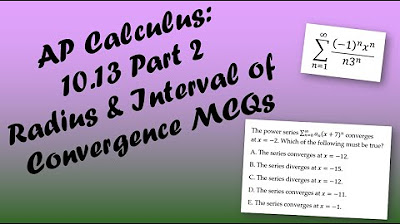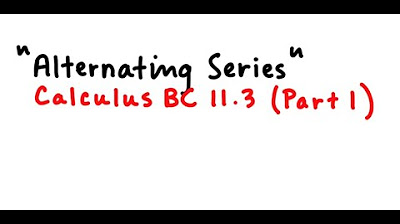Interval of convergence for derivative and integral | Series | AP Calculus BC | Khan Academy
TLDRThis video script delves into the operations of differentiation and integration of power series, illustrating how these can be performed term by term. It explains the concept of the interval of convergence, using the ratio test to determine it for both the original power series and its derivatives and integrals. The script highlights the subtle differences in convergence at the endpoints and encourages viewers to apply these concepts to find the intervals for themselves, noting the harmonic and alternating series as special cases.
Takeaways
- 📚 Derivatives and integrals of power series can be computed term by term.
- 🧮 The derivative of a power series f(x) is the sum of the derivatives of each term.
- ⚖️ Taking the derivative term by term simplifies to the original series shifted by one exponent.
- ✍️ Integrating a power series term by term involves incrementing the exponent and dividing by the new exponent.
- 🔄 The ratio test is used to determine the interval of convergence for a power series.
- 📐 For the given series, the ratio test shows convergence when the absolute value of x is less than 1.
- ↔️ The interval of convergence for the original series is -1 ≤ x < 1.
- 🌀 The geometric series converges when the absolute value of the common ratio is less than 1.
- 🔍 When taking the derivative of the original series, the interval of convergence changes slightly, excluding -1.
- 🔗 All series derived from the original have the same radius of convergence but may differ at endpoints.
Q & A
What does 'term by term' mean when dealing with power series?
-When taking the derivative or integral of a power series, 'term by term' means performing the operation on each term of the series individually, and then summing the results.
How do you find the derivative of a power series?
-The derivative of a power series is found by differentiating each term of the series with respect to x, resulting in a new series where each term is \( n \times x^{n-1} \), and then summing these differentiated terms.
What is the derivative of \( x^n \) with respect to x?
-The derivative of \( x^n \) with respect to x is \( n \times x^{n-1} \).
How does the derivative of a power series affect the terms of the series?
-The derivative of a power series results in each term's exponent being decreased by one, and the series becomes a sum of these new terms.
What is the process for integrating a power series?
-Integration of a power series is done term by term, incrementing the exponent of each term by one and dividing by the new exponent, and then summing these integrated terms.
What is the general form of the integral of a power series term?
-The integral of a power series term is \( \frac{x^{n+1}}{n+1} \), where n is the original exponent of the term.
Why is it important to consider the interval of convergence when working with power series?
-The interval of convergence is crucial because it defines the range of x values for which the power series converges. Operations like differentiation and integration are only valid within this interval.
What is the ratio test and how is it used to determine the interval of convergence?
-The ratio test is a method used to determine the convergence of a series by examining the limit of the ratio of consecutive terms as n approaches infinity. If the limit is less than 1, the series converges; if greater than 1, it diverges; and if equal to 1, the test is inconclusive.
How does the interval of convergence for a power series change when you take its derivative?
-When taking the derivative of a power series, the interval of convergence may change at the endpoints. The radius of convergence remains the same, but the behavior at the endpoints (whether the series converges or diverges) can differ.
What is the interval of convergence for the original power series discussed in the script?
-The interval of convergence for the original power series is from -1 to 1, not including -1 and 1, because the series diverges at these points.
How does the interval of convergence for the derivative of a power series compare to the original series?
-The interval of convergence for the derivative of a power series is generally the same as the original series, except it does not include the endpoints where the original series diverges, such as -1 and 1 in this case.
What is the interval of convergence for the antiderivative or integral of the original power series?
-The interval of convergence for the antiderivative includes the endpoints -1 and 1, as these points converge due to the nature of the integral operation, even though the original series diverges at these points.
How can you determine if a power series converges at the endpoints of its interval of convergence?
-To determine convergence at the endpoints, one must evaluate the series directly at those points, as the ratio test becomes inconclusive. For example, when x equals 1 or -1, the series must be evaluated to see if it converges or diverges.
Outlines
📚 Derivatives and Integrals of Power Series
This paragraph discusses the process of taking derivatives and integrals of power series term by term. The instructor explains that the derivative of a power series function f(x), denoted as f'(x), is obtained by differentiating each term of the series, resulting in a new series where each term is x to the power of (n-1). Similarly, integrating a power series involves summing the terms with an incremented exponent, divided by the new exponent, n+1. The instructor emphasizes that these operations are valid within the interval of convergence for the series and invites viewers to determine the interval of convergence for the given series using the ratio test. The ratio test is applied to find the limit of the ratio of consecutive terms, and the series is convergent if the absolute value of x is less than one, divergent if greater than one, and inconclusive if equal to one. Special cases when x equals one or negative one are also discussed, noting that the series diverges at x=1 but converges at x=-1 due to the alternating nature of the terms.
🔍 Intervals of Convergence for Power Series and Their Derivatives
The second paragraph delves deeper into the intervals of convergence for both the original power series and its derivative. The instructor points out that the interval of convergence for the derivative of a power series is similar to that of the original series but with a slight difference at the endpoints. By recognizing the derivative as a geometric series with a common ratio of x, the convergence is determined by the absolute value of x being less than one, thus excluding the endpoints. The interval of convergence for the derivative is from negative one to one, excluding negative one. For the integral or antiderivative of the original series, the radius of convergence remains the same, but the series converges at both endpoints, x=±1. The instructor encourages the use of the ratio test and boundary conditions to determine the interval of convergence for the integral. The summary highlights the importance of understanding how the intervals of convergence can differ at the endpoints despite having the same radius of convergence.
Mindmap
Keywords
💡Power Series
💡Derivative
💡Integral
💡Term by Term
💡Interval of Convergence
💡Ratio Test
💡Harmonic Series
💡Alternating Harmonic Series
💡Geometric Series
💡Endpoint
💡P-Series
Highlights
Derivatives and integrals of power series can be taken term by term.
The derivative of a power series is the sum of the derivatives of each term.
The derivative of \( x^n \) is \( n \times x^{n-1} \).
The derivative of a power series results in \( x^{n-1} \) after canceling terms.
Integration of a power series is also done term by term.
The integral of a power series results in \( \frac{x^{n+1}}{n+1} \).
The interval of convergence for a power series is crucial for these operations.
The ratio test is used to determine the interval of convergence.
The limit of \( \frac{x^{n+1}}{n+1} \) as \( n \to \infty \) is \( |x| \).
A power series converges if \( |x| < 1 \), diverges if \( |x| > 1 \), and is inconclusive if \( |x| = 1 \).
When \( x = 1 \), the series diverges as it becomes the harmonic series.
When \( x = -1 \), the series converges as it becomes the alternating harmonic series.
The interval of convergence for the original power series is \( -1 \leq x < 1 \).
The derivative of a power series is a geometric series with a common ratio of \( x \).
The interval of convergence for the derivative is \( -1 < x < 1 \), excluding the endpoints.
The antiderivative of a power series converges at the endpoints, unlike the original series.
The interval of convergence for the antiderivative is \( -1 \leq x \leq 1 \).
The radius of convergence is the same for the original series, its derivative, and its antiderivative.
The endpoints of convergence can differ significantly for derivatives and antiderivatives.
Transcripts
Browse More Related Video
5.0 / 5 (0 votes)
Thanks for rating:





